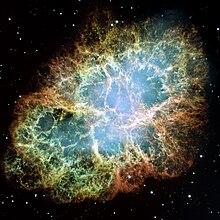Supernova 1054
The SN 1054 was a July 4, 1054 in the eastern part of the constellation Taurus appeared supernova . It reached a brightness of −6 mag and was thus the second brightest object in the daytime sky even before Venus . The remnant of Supernova 1054 is the Crab Nebula (M 1).
Confirmed evidence of the observation of Supernova 1054 could be found in records from the Song dynasty , such as the works Song Shi and Wenxian Tongkao , which were written in 1343 and 1317, respectively, and the appearance of the Nova described here as a "guest star" on the 4th July, or the song Huiyao , which described the nova as "visible in the day as Venus"; as well as in Meigetsuki , written two hundred years later in Fujiwara no Teikas , in which he described the appearance of a "new guest star [...] as big as Jupiter " for late May 1054 . The Arab doctor Ibn Botlan in Fustat described a new star for the year 446 of the Arabic calendar (April 12, 1054 to April 1, 1055). In the records of the Song Dynasty, it is also mentioned that the guest star was no longer visible on April 6, 1056.
There are no reliable observations for Europe for this period. Other authors such as Collins et al. however, refer to similar observations, which, however, precede the Chinese two months, as with a monk in Flanders (April 11, 1054 as a bright disk in the afternoon ), from Ireland (April 24, 1054 as a glowing column ), Rome (end of April 1054 as bright star ), Armenia (May 14, 1054 as a star ), Italy (end of May 1054 as a very bright star , date uncertain) and from Constantinople (1055 as a star ). Collins et al. indicate that the light curve corresponds to that of a Type II supernova and that the light of the supernova explosion would have been perceived on Earth on April 11, 1054.
The supernova of 1054 may also be depicted on Native American petroglyphs from the southwestern United States . A bright star appears on them not far from the crescent moon, as the supernova of the time near the waning moon could also be observed. However, no exact dating of the rock drawings is possible; possibly the star portrayed on them next to the moon is Venus .
See also
literature
- George W. Collins II., William P. Claspy, John C. Martin: A Reinterpretation of Historical References to the Supernova of AD 1054 . In: Publications of the Astronomical Society of the Pacific . Vol. 111, July 1999, pp. 871-880 , doi : 10.1086 / 316401 .
- F. Richard Stephenson, David A. Green: Was the supernova of AD 1054 reported in European history? In: Journal of Astronomical History and Heritage . Vol. 6, No. 1 , 2003, p. 46–52 , bibcode : 2003JAHH .... 6 ... 46S .
Web links
- Supernova 1054 - Creation of the Crab Nebula ( Memento from July 5, 2008 in the Internet Archive )
- http://users.adelphia.net/~parsec32/Pages/supernov1.htm ( Memento from September 30, 2007 in the Internet Archive )
- scinexx .de: Mystery of Supernova 1054 August 27, 2004.
- Video Lesch's Kosmos: July 4th, 1054 and the consequences (January 31, 2011, 1:20 am, 4:01 pm) in the ZDFmediathek , accessed on February 10, 2014.
Individual evidence
- ^ Stephenson, Green: Was the supernova of AD 1054 reported in European history? , Pp. 46-47.
- ^ Stephenson, Green: Was the supernova of AD 1054 reported in European history? , P. 51.
- ↑ Collins, Claspy, Martin: A Reinterpretation of Historical References to the supernova of AD 1054 . In: Publications of the Astronomical Society of the Pacific Band = 111 . No. 761 , 1999, p. 871-880 , bibcode : 1999PASP..111..871C .
- ↑ Crab Nebula . In: Joachim Herrmann: Bertelsmann Lexikon Astronomie , 1993, ISBN 3-570-01612-9 , p. 62.
